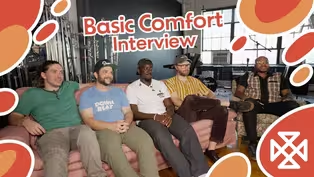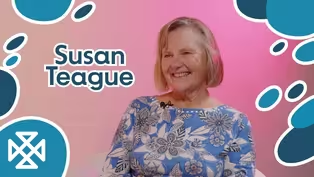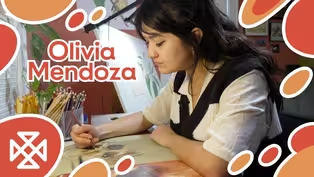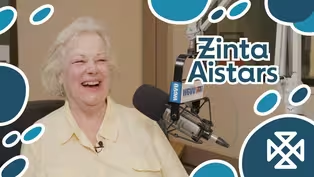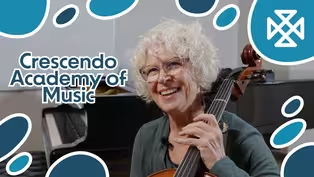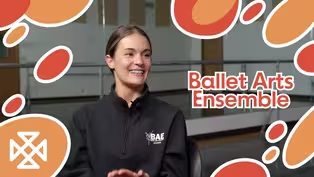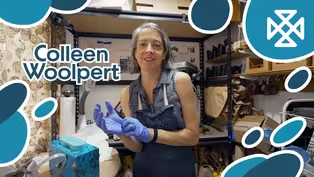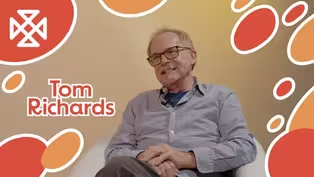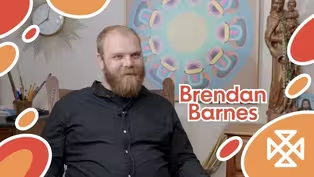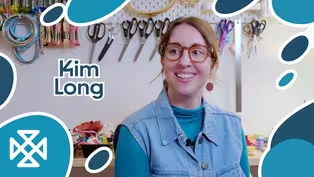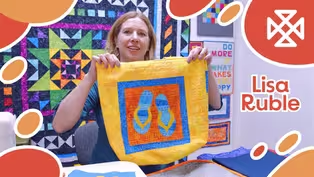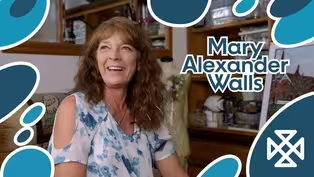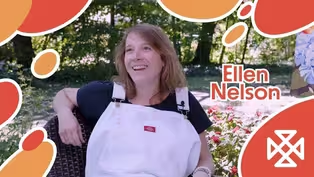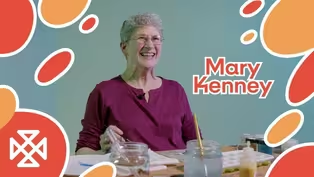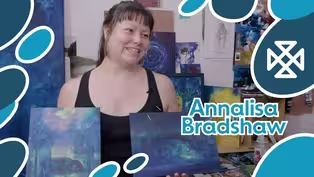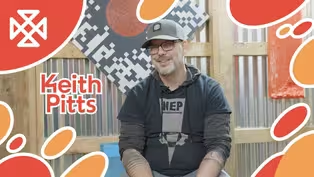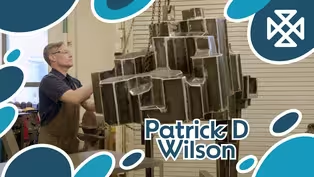Kalamazoo Lively Arts
Reclaiming Wonderment
Clip: Season 9 | 11m 25sVideo has Closed Captions
Brendan Barnes wants to recapture a sense of wonder using mystery, the unknown, and vivid colors!
Brendan Barnes wants to recapture a sense of wonder using mystery, the unknown, and vivid colors to create 3D and 2D art.
Problems playing video? | Closed Captioning Feedback
Problems playing video? | Closed Captioning Feedback
Kalamazoo Lively Arts is a local public television program presented by WGVU
Kalamazoo Lively Arts
Reclaiming Wonderment
Clip: Season 9 | 11m 25sVideo has Closed Captions
Brendan Barnes wants to recapture a sense of wonder using mystery, the unknown, and vivid colors to create 3D and 2D art.
Problems playing video? | Closed Captioning Feedback
How to Watch Kalamazoo Lively Arts
Kalamazoo Lively Arts is available to stream on pbs.org and the free PBS App, available on iPhone, Apple TV, Android TV, Android smartphones, Amazon Fire TV, Amazon Fire Tablet, Roku, Samsung Smart TV, and Vizio.
Providing Support for PBS.org
Learn Moreabout PBS online sponsorship(light music) - Brendan Barnes, let me read.
Your work is about recapturing a sense of wonder, a sense of wonder present in childhood.
So take me back to the little Brendan.
- I mean, I think there's records of me in kindergarten wanting to be an artist.
So like, it's been kind of like the lifelong mission or goal, you know, to be an artist.
And I think things really kinda took off in college.
My work kind of progressed and rapidly, like took off, you know, starting freshman year in college.
- What gave you that decision to study art in college?
- I'm a big skier.
And so like, I was kind of torn between going to like Bozeman, Montana to ski or art school.
And then the deciding factor was really just the scholarship money that they gave me.
So it was affordable, and it was what I wanted to do.
So it was hard to give up a ski, you know, life.
But I'm glad I did, so.
(light music) - What angle did you choose when it came to being an artist?
- Well, I've always been a sculptor, right?
I've always been sort of attracted to sculpture.
I started off at Cleveland Institute of Art in the sculpture department and spent a year there.
I kind of rapidly was a little overwhelmed by the whole experience, but I took a lot from that first year in sculpture.
Transitioned into ceramics where I graduated with my BFA in ceramics.
I have a quite a robust artist practice, which I guess is, you know, like the dream, as you might say.
I mean, like, I think we all want some sort of adventure in our life.
And for me I find that in art.
Yeah, no, it's, I don't need to travel to- Travel's great, but I don't need to go adventures elsewhere.
My adventures are here, so.
- [Shelley] Describe your art today.
- It's ever evolving, seeped in a kind of contemplative practice.
And that's a hard thing to define, but that's really what I've discovered is what I do.
- [Shelley] Talk a little bit about color, and form, and your choice.
- Vibrant colors tend to be what works for what I'm going for.
When I was in college, one of the professors joked with me.
He was like, you don't use color, you use like tone, right?
'Cause I just would use the natural like, you know, color of the object.
There was like a little bit of the history of the work, and the transition from 3D to 2D was working at an adult foster care place.
Current job is working at the Arc.
It's a homeless shelter for youth, right?
So I've been in social work as kind of my day job for a while.
But this, in this adult foster care work position, the people that we were kind of like caring for would go to the rooms at around like seven o'clock.
And then, so you have like five hours of just sort of like nothing to do.
So I picked up crayons, right?
And just started making.
I mean, I didn't, I just was trying to keep myself occupied.
That was one of the very early pieces of that series.
But now I work almost, you know, like more in 2D than I do 3D.
The vibrancy of the color just, you know, grab your attention and captivate you, and seems to be what I gravitate towards.
And then in the sculptures it can be a little bit more subdued.
(light music) - And let's stick with what's on the wall.
Is there a theme to how you paint?
- It's a process.
It's a process I discovered late in college, leaving behind what I know and painting from a place of like detachment.
It's about being fully present in the moment and painting from that sort of like meditative or contemplative state.
- Is there a theme of patterns?
- Yeah, yeah.
I mean, I would definitely think that there's themes of patterns.
The symmetry and the patterns and those kinds of things are really a vehicle for finding that space, right?
There's kinda like a central composition.
The idea is that your mind is not ruminating, right?
So it's just sort of like grasped, and then it's just sort of like centered.
- The painting behind you.
- [Brendan] Yeah.
- Describe its theme.
- Well, so that, this right here is, the original painting is about this big.
It's hanging in my living room downstairs.
And I made those designs.
I have a whole bunch of 'em.
And so I photographed them, and I was not satisfied with the reception that that series had.
So I kind of played with it a little bit, right?
When you view my work, you try to grasp what is it.
That like action of like, what is it, are you trying to discern what it is you're looking at?
Not necessarily the point, but the idea is that you just accept it.
So the patterns allow you to appreciate it for what it is rather than trying to figure out what it is.
(soft music) - Tell me about your array of ceramics.
- Those are titled Speaking Stones.
It is a remake or revisiting of my senior project, my BFA work.
So I worked at the Kalamazoo Institute of Art when I made those pieces, and I've been kind of like in and out of their working and volunteering, and I was a resident there as well too for a while.
So like most of the sculptures, that's the studio I use.
Those, that variation of the theme is I made about 10 years ago or so.
They are an air pocket in clay.
So it behaves erratically.
It behaves on its own accord.
It doesn't have any sort of like, you can't control it.
And so that was sort of like a, this was a very big jumping off point for me.
Because you can't control it, it's not a product of my mind, right?
And so it's a natural object rather than a manmade object.
And then the divots there are very meticulously placed in order to finish the composition rather than disrupt it.
So it's this like still point.
That's where the inspiration for all of this work comes from is basically finding that still point.
- How do you do your work?
I'm seeing a turntable.
I'm seeing items of faith.
What space do you put yourself in to create.
- Yeah, music is a huge part of my process.
I find that I work better with people, and music, and people, and like whatever I can to kind of distract myself helps.
I can explain that 'cause it's like, why would you wanna distract yourself?
Well, the idea is to stay one step ahead of my own understanding.
Try to react and make things that I don't intentionally comprehend in order to make something new, something that I don't necessarily like grasp yet, and it's exciting to me.
- [Shelley] Favorite album to paint by.
- Oh, that's too hard.
(both laughing) That's too hard.
I honestly, what I like to do is like put it on shuffle, like all the music, and just put it on shuffle that way I don't know what's coming.
Like I have many, many tricks to, you know, induce this sort of like state that I make from, you know?
And one of them is trying to stay ahead of my mind.
- [Shelley] Who have you looked up to?
- [Brendan] Isamu Noguchi.
You know, Japanese American sculpture is a huge influence.
I would say Joan Miro, surrealists, the abstract surrealists.
- How does Kalamazoo afford you this opportunity?
- I like Kalamazoo, and if there is an artist community, everything like that, I intentionally push the boundaries in my work.
That's what the work is about, and I want to create work that is exciting to me, and that usually means that it can be hard to appreciate it or hard to understand.
You mentioned it, the spirituality component.
Interestingly enough, that's the hardest thing to talk about, but it's an important part to talk about.
I think my work, in order to understand my work is the best that could be understood.
It's a big piece of that, understanding that.
There's a concept called, and I'll explain the term too.
It's called apathetic theology.
It can be kind of summarized by Saint Augustine saying, "If I can understand it, it's not God."
The apathetic theologies that God is transcendent and not understandable.
The work is therefore is trying to be not comprehensible.
It's challenging sometimes.
It's challenging when you're faced with something and you don't know why it exists, but that's why it exists is to challenge you.
You know, hopefully, you know, you have to wrestle with it.
There's a lot of wrestling with my work, right?
So there's a lot of wrestling with like, what is happening?
(Brendan laughs) You know?
- And you're good with that?
- It's, the intent is who I am, you know?
It's what I do and who I am, and it's the type of art that inspires me.
I would say that it may not be for everybody.
What I've encountered with some people is that they want it to be something, right?
I don't intentionally want to confuse or, you know, like make something that is difficult for somebody.
The processes can be, you know, one that you have to wrestle with, you know, so.
- How do you use your art?
Are are you displaying it in Kalamazoo?
Do you sell it or is it for your own enjoyment?
- All of the above.
The art is always for other people, right?
It's always meant for other people, but there's a big part of my practice where I just sit and appreciate what I've done.
(light music)
Connected by the Beat: A Conversation with Basic Comfort
Video has Closed Captions
Clip: S9 | 12m 17s | Hear from the band members on what drives them to create funky and sonically solid music. (12m 17s)
Video has Closed Captions
Clip: S9 | 12m 27s | Susan Teague uses the experience of life to create her own set of art. (12m 27s)
Video has Closed Captions
Clip: S9 | 14m 1s | Olivia is passionate about nature and accuracy, capturing intricate details of nature. (14m 1s)
Video has Closed Captions
Clip: S9 | 11m 32s | A conversation with WMUK's Zinta Aistars. (11m 32s)
Video has Closed Captions
Clip: S9 | 13m 39s | Explore the inspiring world of the Crescendo Academy of Music in Kalamazoo! (13m 39s)
Video has Closed Captions
Clip: S9 | 12m 3s | Step behind the scenes of the Ballet Arts Ensemble in Kalamazoo! (12m 3s)
Video has Closed Captions
Clip: S9 | 12m 3s | Colleen Woolpert creates her own stereoscopes to share her experiences with the world! (12m 3s)
Video has Closed Captions
Clip: S9 | 13m 26s | Tom Richards is a potter who uses an eclectic mix of materials to create truly unique pottery! (13m 26s)
Video has Closed Captions
Clip: S9 | 13m 44s | Heirloom Arts Tattoo aims to create a safe space for LGBTQIA+, BIPOC and neurodivergent folks! (13m 44s)
Video has Closed Captions
Clip: S9 | 11m 25s | Brendan Barnes wants to recapture a sense of wonder using mystery, the unknown, and vivid colors! (11m 25s)
Video has Closed Captions
Clip: S9 | 13m 6s | Kim Long brings whimsical floral designs to felt embroidery! (13m 6s)
Sew Little Fabric, Sew Little Time
Video has Closed Captions
Clip: S9 | 12m 18s | Lisa Ruble sews modern designs and improvisational techniques for a fresh take on quilting. (12m 18s)
Video has Closed Captions
Clip: S9 | 13m 49s | Mary Alexander Walls incorporates form, movement, and most importantly color into her mosaics. (13m 49s)
Video has Closed Captions
Clip: S9 | 11m 20s | Ellen Nelson reaches into the unknown to find what it means to live in those in-between moments. (11m 20s)
Egg-cellent Paintings with Egg Tempera
Video has Closed Captions
Clip: S9 | 14m 49s | Mary Kenney is a painter, but uses a special ingredient in her pigments. Egg! (14m 49s)
Video has Closed Captions
Clip: S9 | 10m 32s | Annalisa combines light, color, space, and mythology in her oil paintings. (10m 32s)
Shimmering Shadows: Owls and Crows in Gold Leaf
Video has Closed Captions
Clip: S9 | 13m 16s | Karen Bondarchuk guides us through her fascination with corvids and birds! (13m 16s)
Video has Closed Captions
Clip: S9 | 11m 46s | Alexa Karabin shows the magic of making her own paper to paint on. (11m 46s)
Video has Closed Captions
Clip: S9 | 13m 1s | Keith Pitts defies expectations of what a painting can be on Kalamazoo Lively Arts. (13m 1s)
Video has Closed Captions
Clip: S9 | 11m 55s | Patrick D Wilson lights the torch and welds together thousands of pieces of steel! (11m 55s)
Providing Support for PBS.org
Learn Moreabout PBS online sponsorshipSupport for PBS provided by:
Kalamazoo Lively Arts is a local public television program presented by WGVU
